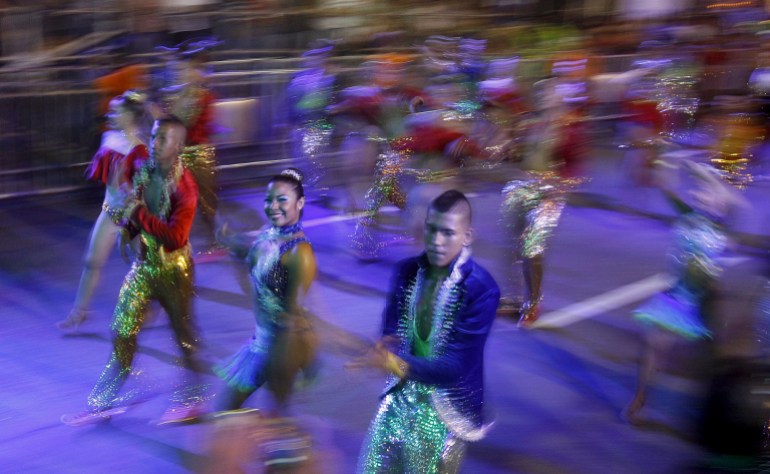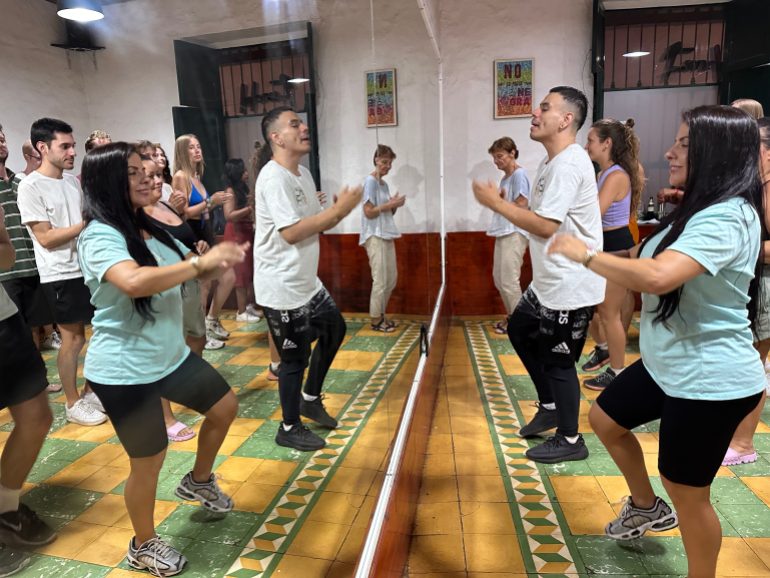
Cali, Colombia – As the only sister of nine brothers, Carmen Diaz enjoyed a lively childhood in the port city Buenaventura, Colombia. She and her siblings would wreak havoc around the house or go out into the street for hours kicking a ragged ball around.
“I loved playing football,” said Diaz, who asked to be called by a pseudonym.
But her joyful, wild childhood came to an end when her uncle began sexually abusing her, she said. The attack lasted several times.
When she told her parents what had happened, they refused to believe her and instead accused her of lying. Desperate, Diaz decided to run away from home at the age of 13.
Diaz eventually slept on the streets of the nearby city of Cali and became addicted to drugs. She eventually found shelter with the city’s social services, which provided her with resources for minors.
This is how she discovered her lifeline: salsa dancing. It was part of an experimental therapy project run by local nonprofit Mi Cuerpo Es Mi Historia, a name that translates to “My Body is My Story.”
The project combines salsa dance and psychotherapy to help survivors of sexual violence express their feelings and process their trauma over several months.
“Dance can help heal trauma,” said project founder Martha Isabel Cordoba Arevalo, a psychologist and avid dancer who was born and raised in Cali, the salsa capital of the world.
“When survivors don’t want to talk about what happened to them or are unable to, exercise gives them another way to express themselves.”
Over the last decade, Mi Cuerpo Es Mi Historia has worked with about 700 young girls, mostly through referrals from city services. Treatment begins with a performance class that focuses on acting, singing or dancing.
The next step is then to give participants the opportunity to explore their chosen themes using performance techniques. At the end of the program, organizers hope that art can provide participants with a way to understand and process their experiences.
However, recovery from trauma is never easy or straightforward. Arevalo remembers meeting Diaz, now 28, when she was still a teenager and had just joined the show. She noticed that Diaz seemed aggressive — hurt by everything she had been through — and didn’t want to interact with the program’s psychologists.
“I was afraid of men,” Diaz said. “The male psychologists I spoke to scared me.”
But Arevalo soon discovered that Diaz had a natural talent for salsa. The teenager seemed more relaxed from week to week.
The fast tempo of the salsa’s tumbao beat occupied Diaz’s mind – and her heels – as she danced around the dance floor, swaying her body to the sounds of trumpets and timbales.
“When I danced, I felt free and happy,” Diaz said. “For me it was the best treatment. I no longer feel like a victim. I am a survivor.”
A growing body of research supports the claim that dance and exercise can have benefits for both the mind and body.
A review by 41 studies The study, published in 2019 in the journal Frontiers in Psychology, found that dance movement therapy reduced anxiety and depression and “consistently” improved associated symptoms.
Dita Federman, a dance movement therapist who has studied sexual abuse, argues that this unconventional treatment method can reach some patients in ways that other interventions cannot.
“It may be critical to helping some patients,” Federman said. “Dance therapy can result in increased heart rate through coordinated movement and balance, and what happens with dancing is that people are more likely to remember and express past memories.”

However, Arevalo warned that combating sexual violence is extremely complex and there is no easy solution.
“You need time and resources, and you need trained professionals to make profound life changes or restorations,” she said. “Not everyone has this luxury.”
Federman also warned that there is a risk of re-traumatization with any type of therapy. Dance is no exception.
“It should happen very slowly, without direct questions [the survivors] for emotional material,” she said. “If it comes from them, it comes. But it shouldn’t be forced.”
And although its effectiveness has been researched, Federman said knowledge of dance movement therapy remains limited due to the difficulty of obtaining approval to study survivors of sexual violence.
“There’s so much we don’t know yet,” she said.
However, advocates believe that dance therapy could help address the drastic problems in small steps gender-based violence in Colombia.
According to the United Nations Global Database on Violence, a third of women in the Latin American country have suffered physical or sexual violence from a partner.
Colombia is six decades long internal conflict has also contributed to high rates of sexual violence. In September, the Special Jurisdiction for Peace – a court investigating crimes committed during the conflict – announced as much 35,178 people had suffered gender-based violence between 1957 and 2016.
Right wing paramilitary groups were responsible for most incidents at around 33 percent. The vast majority of victims were women, 89 percent overall.
“Women’s bodies have been used as a war target,” Arevalo said.
To reduce the risk of re-traumatization, Arevalo avoids using “direct” dance partners in her sessions with young survivors. Instead, dancers learn their steps in a larger, coordinated group. And when they mate, they often use a technique called “mirroring,” in which dancers mimic their partner’s movements from a distance.
Arevalo said there is also a lot of room for individual improvisation in salsa, which can be danced both alone and with others.

Her nonprofit offers sexual assault survivors the opportunity to become salsa instructors themselves so they can pass on their techniques to others—or even start their own business.
Sofia Murillo is one of the graduates of this program. On a December afternoon, she and fellow teacher Alexander Patiño explained the basic salsa steps to about 25 tourists in a crowded dance studio with bright yellow and green tiles.
Cali’s brand of salsa is known for its fast tempo: in the 1970s, it became popular for DJs to play records at 45 rpm, much faster than the usual speed of 33 rpm.
Faced with Cali’s whip-fast beats – the galloping pulse of bongos and cowbells seemed relentless – Murillo’s students struggled to keep up. Their toe movements and twists risked causing collisions and crushed feet.
But by the end of their course, all the tourists had managed to put together a respectable routine.
“I used to have negative thoughts,” said Murillo, 40, who became a salsa teacher in 2023. “I was mistreated. But when I dance, it’s different. I forget everything. I smile.”






Recent Comments